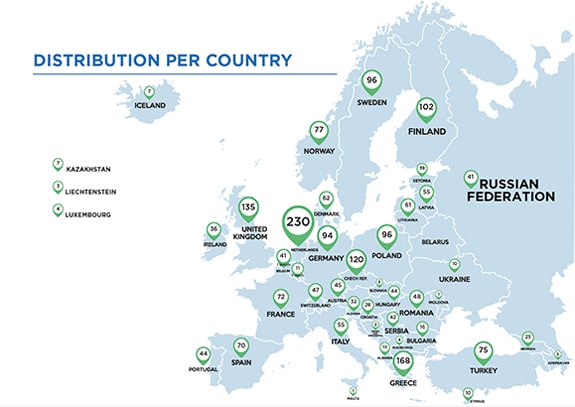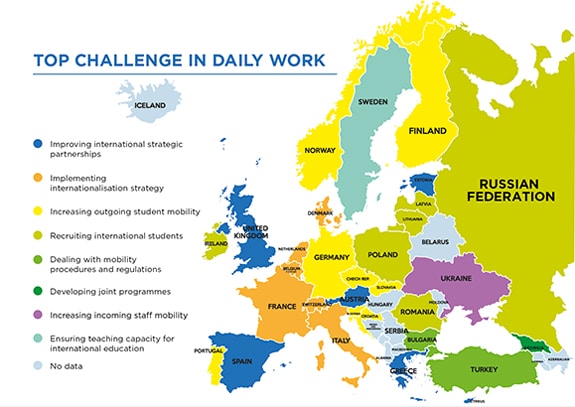EAIE measures the state of internationalisation in Europe
A majority of higher education institutions in 33 European countries say that increasing international revenue is not the main rationale behind their internationalisation initiatives. Instead, it is to improve the overall quality of education they are able to provide students. This is one of the major findings of a new study from the European Association of International Education (EAIE): The EAIE Barometer: Internationalisation in Europe. “The definition of internationalisation has evolved since the 1980s, when the focus was on social and political rationales. In the late 1980s, internationalisation was commonly defined at the institutional level and in terms of a set of activities,” says an extended Executive Summary of the report released by EAIE. “Over time, rationales, providers, stakeholders and manifestations of internationalisation have changed.” Those changes have led to the following working definition, which has been widely accepted by scholars and practitioners in the field:
“Internationalisation at the national/sector/institutional levels is defined as the process of integrating an international, intercultural or global dimension into the purpose, functions or delivery of post-secondary education.”
The EAIE Barometer examines the state of internationalisation in the European Higher Education Area (EHEA) based on a survey of 2,411 education professionals working at approximately 1,500 higher education institutions from 33 countries in the EHEA.

- International partnerships (53%);
- Management of international offices (35%);
- International funding programmes (29%);
- Internationalisation policies (22%).
An interesting element of the survey report is that it classifies institutions in terms of their internationalisation profiles: "leading, average, and lagging." This segmentation allows for an analysis of what staff at institutions just beginning their internationalisation efforts – or encountering issues in their implementation – might need to achieve more success.
Internationalisation to raise the quality of education
Most respondents to the EAIE survey cited non-monetary reasons for the internationalisation of their campuses: 56% said the main rationale was to “improve the quality of education” and 45% said it was to “prepare students for a global world.” Attracting international students and improving the reputation of an institution were also cited by many respondents (37% and 35%, respectively), as was improving the quality of research and development. Least important according to educators was “financial benefits for the institution” (10%). “Institutions regarded as leading are commonly perceived as having a stronger focus on improving the overall quality of education,” says EAIE in summary. “Notably, institutions perceived as lagging behind in internationalisation are indicated to have a stronger focus on the financial benefits of internationalisation.”
Factors common to institutions leading in internationalisation
Institutions classified as “leading” in terms of internationalisation are more likely to have developed unique, separate strategies for internationalisation as opposed to incorporating internationalisation within a larger institutional strategy. EAIE adds in its Executive Summary: “At the vast majority of institutions… student mobility appears to play the most significant role in strategic plans for internationalisation. Aspects such as strategic partnerships (79%) and international research and innovation (79%) also seem to enjoy a large consensus amongst institutions. Staff mobility is also a significantly high priority (73% outgoing and 71% incoming). Internationalisation of the curriculum appears as part of strategies developed at 68% of institutions, and internationalisation at home in strategies at 56%.” EAIE highlights that leading institutions also prioritised international research and innovation in their institutional strategies relative to other institutions. The report notes this emphasis is generally indicative of institutions committed to improving quality as well as linked to such institutions’ greater focus on maintaining or elevating their reputation or their position in international rankings. The report also notices a link between institutional and/or national monitoring of internationalisation activities and gains in internationalisation; in cases where there is little monitoring there is a slower growth trend. The report also notes:
“Higher education institutions leading in internationalisation monitor and evaluate internationalisation developments more often than institutions regarded as average.”
Staff at leading institutions with more defined and separate international education strategies were more likely to feel satisfied with their current level of expertise in their jobs, which they said includes the following main challenges:
- Improving international strategic partnerships (40%);
- Increasing outgoing student mobility (37%);
- Implementation of the internationalisation strategy of the institution (35%).
The following graphic depicts the top challenge practitioners identified in various countries.

Internationalisation gaining momentum
The report found that the trend to internationalise has been gaining steam over the past three years, as evidenced by such measures as:
- Growing implementation of international strategic partnerships;
- Efforts to improve the quality of services for international students;
- Efforts to improve the quality of international courses and programmes;
- An increase in incoming and outgoing exchange students and incoming international degree students;
- An increase in the number of courses and programmes with an international component and taught in English.
Respondents pointed to both gains in, and challenges with, establishing strategic partnerships. More than half (55%) have noticed an increase in the number of strategic partnerships their institution is implementing (20% “substantial”), and 40% also said that strategic partnerships are an area of significant challenge for them. “The most overt manifestation of internationalisation in higher education is mobility of students and staff,” says EAIE. “High visibility is also given to international partnerships and projects, research initiatives, cross-border delivery and branch campuses or franchises using face-to-face or distance learning platforms.” The most influential factor respondents cited as driving their institutions’ internationalisation efforts was internal institutional priorities (54% “strong influence”), with national level policy (41%) and EU-level policies (38%) next.
Knowledge needed more than skills
The survey found that on average, respondents feel the need for knowledge as opposed to skills. They are hoping to receive more of the following:
- Market intelligence;
- Materials to guide them in their strategies;
- Information on external funding programmes.
On these findings, EAIE Executive Director Leonard Engel pointed out, "It doesn’t come as a surprise that people feel a stronger need for knowledge. I suppose this has a lot to do with a lack of time professionals have to read up on developments, combined with the pace of changes in the field."
From the report to the field
The EAIE Barometer provides a significant contribution to European higher education institutions' intent on increasing the quality and volume of their campuses’ internationalisation initiatives, not the least because it identifies the areas where the staff of such institutions feel they could improve or are missing needed supports. Mr Engel told us: “For an association like the EAIE, it is important to focus on the knowledge and skills professionals in the field deem necessary to do their jobs better; only with skilled and knowledgeable staff, equipped with the right tools at their disposal, can internationalisation reach its true potential.” Sara López Selga, Director of International Relations at Universitat Pompeu Fabra contributed to the development of the Barometer study and is enthusiastic about the opportunities it offers to international education practitioners. She says: “The EAIE Barometer provides international educators with relevant comparative data on the rationales and strategies of higher education internationalisation in Europe. It reveals strategic partnerships and student mobility as current trends and sheds light on developments in university practice, helping us to identify common ground but also different priorities for collaboration." Interesting to all institutions - whether included in the survey, in Europe, or elsewhere - will be the EAIE Barometer’s findings on what leading institutions are doing differently in their internationalisation strategies.
It seems that establishing a distinct area of focus within an institution to internationalisation - complete with its own expertise, goals, and budget - is part of a winning formula for many of the leading institutions.
The EAIE summary concludes: “The findings show that higher education institutions leading in internationalisation have several characteristics in common. Typically, such institutions either have a fully developed strategic plan for internationalisation or internationalisation is a specific priority within the overall institutional strategic plan. Their strategic plans tend to concentrate heavily on international research and innovation, but also frequently include features such as strategic partnerships, international rankings and international marketing and promotion.” In other words, “Strategic attention to internationalisation helps increase the chances of success.”















